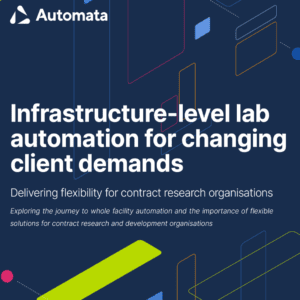For contract laboratory managers navigating the complexities of selecting the right automation system, and ensuring the chosen solution is future-proofed, is a challenge.
A diverse client base and the need for reliable, high-quality results, data transparency and the flexibility to respond to demand means that many traditional solutions may fall short on delivering against both short-term needs and long-term goals.
To help CROs and CDMOs find a flexible automation solution that aligns with their evolving needs, we’ve compiled some tips and guidance to help you ensure the provider you choose is the right one for you.
This article is an extended version of a chapter featured in our latest whitepaper.

Research phase
1. Analyse your existing capabilities
Assess your lab’s existing workflows, challenges, and automation requirements and identify specific pain points that automation can address, such as repetitive tasks, sample processing bottlenecks, or data management inefficiencies.
From there, it’ll be easier to rule certain types of automation – and therefore suppliers – in or out, and it’ll give you a benchmark on which to improve.
For contract labs, research may also involve exploring missed opportunities – times when you could have delivered more for the client or taken the contract if lab processes were faster, for example.
2. Look to the future
Whether you’re automating an existing workcell/flow or designing a new one, future-proofing is critical. Envision the future trajectory of your lab, considering potential expansions or mergers, changes in research or client focus, and scalability requirements over the coming years.
Look for modular, flexible automation platforms that allow incremental expansion and integration of new functionalities as your lab’s needs evolve. Avoid vendor-specific solutions if possible.

Scalability through modular, flexible solutions like LINQ ensures that your automation investment remains relevant and effective in accommodating increased workloads and emerging technologies – the latter of which will be an unavoidable part of the evolution of your lab and practises.
3. Decide how to fund your purchase
Flexible automation solutions support evolution, but, particularly when monitoring return on investment, both short and long-term goals should be considered.
You’ll also need to decide whether your budget comes from OPEX or CAPEX, and some providers, like Automata, have financing options based on improvement results, such as pay-per-plate.

Implementation phase
1. Consider a change management programme
Depending on the usage of and attitudes towards automation within your current organisation, the first implementation stage may be rolling out an internal change management programme. This should seek to alleviate concerns but, more importantly, highlight the features and benefits of the incoming solution and how it will support day-to-day lab life as well as business-wide goals.
Your supplier should be able to help with this, and they should provide you with training and documentation to help existing and future employees.
Most labs operate across a variety of teams and skill sets so ensure everyone, regardless of their experience with automation, can understand the project and the intended results.
2. Make sure you can accommodate downtime
There will, inevitably, be a time when lab operations need to be paused for migration to the new system – unless you’re moving to a new space. While this may be slightly easier for contract labs to schedule, there may still be revenue implications, so build that shortfall into your budget.
A phased implementation may be an option; relocating some must-run processes to other facilities could be planned for a short time, and some of our clients choose to run the non-automated solution alongside the automated one for a more staggered transition.
Automata has a low-downtime implementation process, and our solution has been designed to be as intuitive as possible to ensure high levels of adoption and immediate impact – critical for CROs and CDMOs who have no time to waste!
3. Find a supportive partner
What sets some providers apart from others is:
- The period right after the physical components are in place
Implementation isn’t just about getting the hardware set up and the software installed; it’s how quickly the solution gives a return on investment, how well adopted the solution is, and how easy it is to optimise it.
Automata has a period of hypercare post-implementation, where we’ll work to optimise your system and support your new users. We’ll discuss how long this period will be during project scoping because post-project care isn’t one size fits all.
- What happens when system changes are needed
Choosing a user-friendly automation platform is paramount for contract labs that may not employ full-time automation specialists, at least initially, but the provider should still support change requests too.
Your Automata customer success team will also include scientists and hardware and software engineers who can help you tweak the system, from workflow design to execution, to instrument calibration and data flow.
Optimisation phase
Once your automation has been executing live workflows, delivering real results and transferring quality data for some time, further chances to optimise instruments and instructions will become apparent.
Many solutions still don’t provide end-users with the ability to interrogate audit logs, which makes proactive maintenance, optimisation, and troubleshooting next to impossible.
Platforms like LINQ unlock users’ ability to assess and optimise automated processes across the lab quickly and easily because all the information, from run instructions to audit logs to error reports, is available.
For contract labs, access to this data can expedite identifying operational efficiencies, supporting cost-savings and strengthening that all-important profit margin.
By prioritising flexibility, scalability, user experience, and vendor support, contract lab managers can benefit from immediate competitive advantage while laying the foundations facility-wide or even infrastructure-level automation – the ultimate way to deliver high-quality, high-throughput, truly innovative scientific laboratory services.
See how the path to automation, from system selection to exponential expansion, can be made simple for contract research, development and manufacturing labs in our latest whitepaper: Infrastructure-level lab automation for changing client demands: delivering flexibility for CROs.



